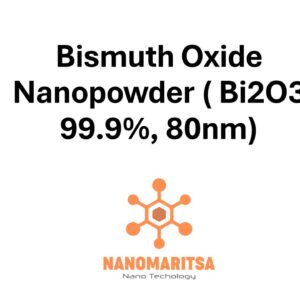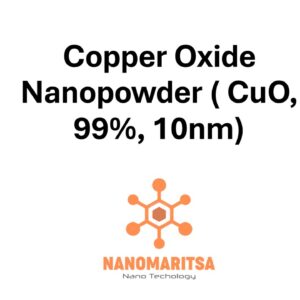Magnesium oxide nanopowder (MgO, 99+%, 20 nm) is a high-quality, advanced material known for its excellent thermal conductivity, electrical insulating properties, and versatility in various applications. With a purity of 99+% and a particle size of 20 nm, this nanopowder offers enhanced surface reactivity and stability, making it a valuable material in industries ranging from electronics to energy storage and environmental protection.
Composition and Structure
MgO (Magnesium Oxide):
Magnesium oxide is a simple inorganic compound composed of magnesium and oxygen. It is widely known for its high melting point and ability to function as a refractory material, making it suitable for use in harsh environments. The nanopowder form, with particles sized around 20 nm, enhances its surface area, reactivity, and interaction with other materials in various technological applications.
Purity (99+%):
The high purity (99+%) ensures that the magnesium oxide nanopowder is free from most contaminants, which is particularly crucial for applications where material integrity and performance are critical.
Particle Size (20 nm):
The 20 nm particle size provides a balance between surface area and material stability. At this scale, the nanopowder exhibits enhanced reactivity, better dispersion, and improved interaction with other materials, which is advantageous in applications like catalysis and energy storage.
Properties
- Increased Surface Area:
Due to its small particle size, magnesium oxide nanopowder has a significantly larger surface area compared to its bulk counterpart, which improves its performance in catalytic processes, adsorptive applications, and reactions that require increased surface interaction. - High Thermal Stability:
Magnesium oxide has a very high melting point (over 2800°C), which makes it ideal for use in high-temperature applications, including as a refractory material in furnaces, kilns, and other industrial equipment. - Electrical Insulation:
Magnesium oxide is an excellent electrical insulator, which makes it useful in electrical and electronic components that require high resistance to electrical currents. - Chemical Stability:
MgO is chemically inert in many environments, meaning it resists corrosion and degradation, even under challenging chemical conditions. This property is crucial for long-lasting and reliable performance in harsh industrial settings. - Optical Properties:
Magnesium oxide is transparent in ultraviolet light, which makes it useful in optical and photonic applications where transparency and low refractive index are important.
Applications
1. Electronics and Electrical Insulation:
High-Voltage Insulators:
Magnesium oxide is commonly used as an insulating material in high-voltage equipment, such as transformers and electrical cables. Its excellent insulating properties prevent electrical breakdown, making it an essential component in power transmission systems.
Semiconductor Devices:
Due to its stable dielectric properties, MgO nanopowder is utilized in semiconductor technologies, including in capacitors, where it helps improve performance by providing effective insulation.
Thermal Insulation in Electronics:
In electronic devices, MgO serves as a thermal insulator, protecting sensitive components from heat damage in high-performance electronics, such as heat sinks and thermal coatings.
2. Catalysis:
Catalyst Support:
MgO nanopowder is frequently used as a support material for catalysts in various chemical reactions, such as petroleum refining, where it enhances the efficiency and selectivity of the catalytic process.
Environmental Catalysis:
In environmental applications, magnesium oxide nanopowder serves as a catalyst for processes aimed at reducing pollution, such as the removal of sulfur compounds and nitrogen oxides from industrial emissions.
Fine Chemical Synthesis:
MgO is utilized in the production of fine chemicals, serving as a catalyst in processes like oxidation, dehydrogenation, and the synthesis of biofuels and other industrial chemicals.
3. Energy Storage and Conversion:
Batteries:
MgO nanopowder is used in energy storage devices like lithium-ion and solid-state batteries, where its thermal stability and insulating properties improve the efficiency and safety of these systems.
Supercapacitors:
MgO’s large surface area and chemical stability make it suitable for use in supercapacitors, which store energy and provide high power output in applications requiring rapid charge/discharge cycles.
Photocatalysis and Solar Energy:
Magnesium oxide nanopowder is involved in photocatalytic processes for energy conversion, such as water splitting for hydrogen production. It can help convert solar energy into chemical energy, contributing to renewable energy technologies.
4. Environmental Applications:
Water Treatment:
MgO nanopowder is used in water purification processes, where it helps adsorb heavy metals, phosphates, and other pollutants, improving the quality of water in industrial, agricultural, and urban settings.
Pollutant Removal:
Magnesium oxide is effective in the removal of various pollutants from the air and water, particularly in the degradation of harmful compounds such as sulfur and nitrogen oxides, as well as volatile organic compounds (VOCs).
Carbon Capture:
MgO is used in carbon capture technologies, where it reacts with carbon dioxide to form stable magnesium carbonate, helping mitigate the effects of industrial CO₂ emissions.
5. Pharmaceuticals and Medicine:
Drug Delivery Systems:
Magnesium oxide nanopowder is being explored for drug delivery applications, where its biocompatibility and small size allow it to efficiently carry and release drugs at specific sites within the body.
Antimicrobial Properties:
MgO is known to possess antimicrobial properties, making it useful in medical applications such as wound care and as an additive in personal care products to prevent bacterial growth.
Safety and Handling
Health Considerations:
Magnesium oxide is generally considered safe, but like all nanopowders, it should be handled with care. Inhalation of fine particles may pose a health risk, so proper personal protective equipment, such as dust masks, gloves, and goggles, should be used.
Environmental Impact:
Magnesium oxide is relatively environmentally friendly and is used in many green technologies, including water purification and pollutant removal. However, as with all nanoparticles, proper disposal practices should be followed to minimize any potential environmental impact.
Summary
Magnesium oxide nanopowder (MgO, 99+%, 20 nm) is a highly versatile material that plays a critical role in a variety of industries, including electronics, catalysis, energy storage, and environmental protection. Its high thermal stability, electrical insulating properties, and large surface area make it an ideal choice for applications that demand high performance and reliability. With its high purity and tailored nanoparticle size, MgO nanopowder is essential in advancing technologies related to energy, pollution control, and chemical processes.
| Measurement (gr) | 100 grams, 500 grams, 1000 grams |
|---|
Related products
-
Single-Element Oxides Nanopowder
Dysprosium Oxide Nanopowder (Dy2O3, 99.9+%, 30nm)
0 out of 5(0)SKU: MN09NP0223€304.00 This product has multiple variants. The options may be chosen on the product page -
Single-Element Oxides Nanopowder
Copper Oxide Nanopowder ( CuO, 99%, 80nm)
0 out of 5(0)SKU: MN09NP0220€128.00 This product has multiple variants. The options may be chosen on the product page -
Single-Element Oxides Nanopowder
Bismuth Oxide Nanopowder ( Bi2O3, 99.9%, 80nm)
0 out of 5(0)SKU: MN09NP0211€96.00 This product has multiple variants. The options may be chosen on the product page -
Single-Element Oxides Nanopowder
Copper Oxide Nanopowder ( CuO, 99%, 10nm)
0 out of 5(0)SKU: MN09NP0218€352.00 This product has multiple variants. The options may be chosen on the product page






